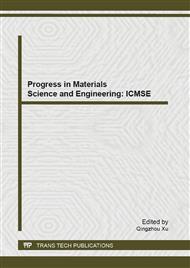p.171
p.179
p.183
p.187
p.195
p.201
p.205
p.212
p.216
Effects of Mixing Melt Treatment and Heat-Treatment on the Microstructure and Wear Resistance of Al-22%Si Alloys
Abstract:
The effect of hypereutectic Al-22%Si alloys prepared by means of Controlled Diffusion Solidification (CDS) followed by subsequent heat-treatment on the microstructure and sliding abrasive wear behaviors is investigated. The results show that the primary silicon morphology, size and distribution can be improved by CDS, especially for the case of liquid-liquid mixing. After heat-treatment, the eutectic silicon can be spheroidized. Under the same load, the wear rates for the identically mixed and heat-treated Al-22%Si alloys are lower than those unheat-treatment, and the wear rate of liquid-liquid mixed and heat-treated Al-22%Si alloy reach its minimum. The wear mechanism of traditional cast Al-22%Si alloy includes adhesive wear and fatigue breaking-off, while the liquid-liquid mixing can effectively restrain flaking on the worn surface and avoid the fatigue breaking-off, the wear mechanism is changed into abrasion wear.
Info:
Periodical:
Pages:
195-200
Citation:
Online since:
October 2013
Authors:
Price:
Сopyright:
© 2013 Trans Tech Publications Ltd. All Rights Reserved
Share:
Citation:


